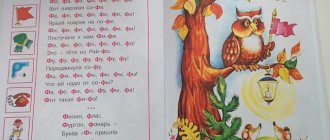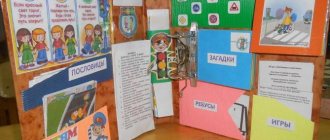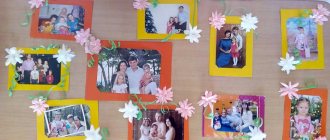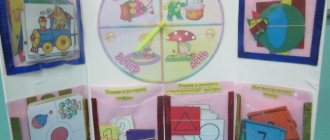Download ready-made templates for environmental laptops.
In the lapbook: natural resources, living and inanimate nature, environmental game “What you can and cannot do in nature,” environmental proverbs
Print out a lapbook on the topic “Garbage”
In the lapbook: sorting waste for subsequent recycling, the time frame for decomposition of waste in pictures.
Photos of homemade lapbooks in author’s blogs on the MAAM portal
Contained in sections:
- Lapbook. Lapbooks on all topics 7430
- Garbage. Let's protect nature from garbage 946
- Ecology for children. Ecolates, nature defenders 4193
- Ecology, nature protection. Didactic games and aids 80
Includes sections:
- Red Book. Lapbooks, homemade manuals 46
Showing publications 1-10 of 249. All sections | Ecological lapbooks
New
Photo
The best
Lapbook “Ecology” Today, one of the most important problems in the world is the problem of ecology . The purpose of the manual: to create conditions for the educational process that ensure the environmental development of preschool children, the formation of the foundations of environmental culture and creative thinking in children...
Lapbook “Ecology” (senior group)
1. Lapbook “ Ecology ”
2. Didactic manual
Lapbook “
Ecology ” is intended for middle, as well as senior preschool age, if the content
of the lapbook is expanded and complicated. 3. Purpose of the work: To consolidate and expand the knowledge of preschool children about ecology and rules...
Lapbook “Love and protect nature”
Participants of the exhibition and competition:
Amirova Nailya Rinatovna - teacher,
Abdurazakova Asiyat Sharapudinovna - teacher of the 1st category,
Makalovich Natalya Aleksandrovna - teacher of the 1st category.
MBDOU d/s "Snezhinka"
Surgut district, Nizhnesortymsky village
«Love and protect nature"
Dear colleagues, I present to your attention an ecological laptop book “Love and Protect Nature”. He
is a folder in which there are pockets with collected information on the topic.
The didactic manual “Lapbook “Love and Protect Nature” is intended for children 4-5 years old. If the content of the lapbook is expanded and complicated, it can be used with children of older preschool age.
This manual is a means of developmental learning and involves the use of modern technologies: technologies for organizing collective creative activity, communication technologies, technology for project activities, gaming technologies.
The purpose of this manual:
consolidate and expand children's knowledge about animals and
flora, about living and inanimate nature, rules of behavior in the forest.
Tasks:
- Clarify and expand children’s understanding of the plant world, its inhabitants, and rules of behavior.
-To consolidate children’s knowledge about trees and their external differences from each other.
-Systematize children’s knowledge about birds, animals, and insects of the park.
-Enrich vocabulary, develop coherent speech, interest in artistic expression.
To cultivate a culture of behavior in the forest, attention, love for nature, a caring attitude towards animals and birds, positive character traits, interest and love for the nature of the native land.
Lapbook contents:
The didactic game “Living and Inanimate Nature” for studying objects of living and inanimate nature consists of pictures of living and inanimate nature, which must be divided into two groups.
Pocket with riddles.
Pocket “Medicinal plants” for securing and studying useful plants.
Pocket with poems about nature.
Didactic game “Rules of behavior in nature” with pictures depicting correct and incorrect behavior in the park, for the development of speech.
Pocket “Finger games” for the development of fine motor skills.
Puzzles “Environmental assortment” - cut-out pictures depicting birds and nature.
Ecological tales.
Coloring pages and games on the topic.
Recommendations for use.
The didactic manual “Lapbook “Love and Protect Nature” is recommended for use by preschool teachers in individual work with children 4-5 years old, in independent and play activities.
Designed for subgroup and individual work in a kindergarten group. This is a good way to consolidate the topic of studying the rules of behavior in the forest, systematize knowledge about trees and forest animals, comprehend the content, and conduct research work, during which the child participates in searching, analyzing and sorting information.
The manual is multifunctional, transformable,
mobile, convenient for both children and teachers.
The material is selected taking into account the individual and age characteristics of children.
The value of a lapbook for preschoolers:
-promotes understanding and memorization of information on the topic,
-promotes the child’s acquisition of skills for independently collecting and organizing information on a topic,
-promotes repetition and consolidation of material on the topic.
Ecological lapbooks – Ecological lapbook “Eco-preschool children” for the middle group
Publication “Ecological lapbook “Eco-preschool children” for secondary…”
[Goal: To convey to children the idea that they need to take care of nature. Objectives: To give children an initial understanding of ecology; Develop cognitive interest; Expand children's knowledge; Strengthen children's knowledge about animals, plants, trees; Cultivate respectful and...
Image library "MAAM-pictures"
Double-sided lapbook on ecology “Ecological assortment”
In the modern world, environmental education is becoming one of the priority areas of preschool educational institutions. Its goal is to form a personality capable of caring for nature, living in harmony with it, and being aware of the consequences of their actions in relation to the environment. To…
Lapbook “Butterflies” in environmental education for preschoolers
In accordance with the requirements of the Federal State Educational Standard for Educational Education, new requirements also appear for the organization of work with children. To make the process of environmental education of preschoolers interesting, it is important to search for new innovative technologies. In the methodological literature you can find a description...
Lapbook on environmental education through didactic games
Didactic games are considered one of the most effective means of teaching and developing preschoolers. Didactic games of ecological content help to see the integrity of an individual organism and ecosystem, to realize the uniqueness of each natural object, to understand that unreasonable...
Lapbook as a means of environmental education for preschool children
Bibliographic description:
Dikova, O.I. Lapbook as a means of environmental education for preschool children / O.I. Dikova. — Text: direct // Questions of preschool pedagogy. - 2022. - No. 7 (44). — P. 21-24. — URL: https://moluch.ru/th/1/archive/201/6503/ (access date: 01/25/2022).
Environmental education of preschool children in the conditions of modern life is becoming one of the priorities. The goal of environmental education is to form a new type of person with new ecological thinking , capable of realizing the consequences of their actions in relation to the environment and able to live in relative harmony with nature.
In connection with the implementation of the Federal State Educational Standard for Education, every teacher is looking for new approaches, ideas, and uses interesting methods and technologies for environmental education in their teaching activities.
Nowadays, children are very inquisitive, but with all this, an active approach remains a priority at their age. That's why I became interested in the Lapbook technology and its application. “Lapbook Ecolyata” is intended for individual and subgroup lessons with preschool children aged 3–7 years.
The methodological manual will be of interest to preschool teachers and parents
Purpose of creation: using a lapbook as a means of teaching environmental literacy to preschool children
Tasks :
- To give preschoolers an initial idea of ecology and nature in general; mastering the basics of environmental literacy and basic rules of behavior in nature.
- Mastering the logical actions of comparison, analysis, generalization, establishing cause-and-effect relationships; teach to classify objects made from different materials into groups;
- Develop children's cognitive interest;
- To foster a respectful, caring attitude towards nature in children.
- Develop skills of cooperation with adults and peers in different social situations, the ability not to create conflicts and find ways out of controversial situations.
“Lapbook” is an independent, research, educational, playful, creative, productive activity for children that meets the requirements of the Federal State Educational Standard for Educational Education for a subject-development environment:
– informative;
– multifunctional;
– suitable for use by a group of children at the same time;
– has didactic properties;
– is a means of artistic and aesthetic development of the child;
– ensures playful, educational, research and creative activity for all pupils.
Expected Result:
– ability to plan upcoming activities;
– negotiate with peers; distribute responsibilities;
– search for the necessary information, summarize it, systematize it;
– independently provide explanations to questions that arise;
– make your own decisions, based on your ideas and skills, make choices;
– use oral language, express your thoughts, attitudes, desires.
I want to share with you my first impressions of working on a LAPBUK. Probably the most difficult stage in creating a lapbook for me was choosing a topic and filling the manual with environmental games. But the process itself gave me a lot of positive emotions.
Working on a laptop is quite varied. One of the many positive aspects of a lapbook is the fact that a lapbook is an amazing DIY educational tool. The lapbook itself is very interactive, from the process of its creation to the finished result.
Contents of the teaching aid: “Ekolyata Lapbook” is presented in the form of a folding folder with two spreads.
On each spread, cover, back and front sides there is educational material, games, exercises, tasks that help a preschooler comprehend the basics of environmental literacy. The internal content of the laptop changes and is updated.
On the first spread of the lapbook, we introduce children to the concept of “ecology”. Educational games: “Nature conservation”, “Be nature’s friend!”, “Why is the planet sad, why is it happy?”, “Garbage sorting”
The next spread of our lapbook presents environmental games “Seasons”, poems, riddles, puzzles, “Algorithm for the seasons”, pockets for little books for individual work on telling about the seasons, lacing “Inhabitants of the Ecosystem”, little books “ Wintering and migratory birds", "Shadow Games"
What is attractive about this form of work?
For children, this is a bright, interesting book; they want to look at it and study it. The advantage of the methodological guide is the ability to involve children in active joint, independent activities, which is ensured by a variety of subject content, aesthetics, safety, accessibility and ease of placement of materials. Such an unusual presentation of the material will certainly attract the child’s attention, and he will return to this folder more than once to look through it, play with it, and at the same time, unbeknownst to himself, repeat the material he has covered.
I really like the classes using the innovative gaming technology “Lapbook”, and most importantly, children like these games, which is a successful step towards the development of environmental education for children. A laptop is a great way to acquire, expand and consolidate knowledge on a specific topic. The children's horizons expanded, their mental activity improved, the research process itself improved, and the result brought joy to the children.
Literature:
- https://www.maam.ru/obrazovanie/lepbuk-ekologiya
- https://eco-apatity.jimdofree.com/
- https://portaleco.ru/ekologicheskaja-azbuka/ekologija-zemli.html
- https://www.zelife.ru/ekogid/library.html
Lapbook “Save the planet together”
Lapbook “Save the planet together”
Today, one of the most important problems in the world is the problem of ecology. The laptop “Save the Planet Together” is intended for children of senior preschool age. The material is selected taking into account the individual and age characteristics of children. This manual is a means of developmental learning and involves the use of modern technologies: technologies for organizing individual activities, communication technologies, technology for project activities, gaming technologies.
Goal: consolidation and formation of the principles of ecological culture: the child’s correct attitude to nature, to the world around him, to himself, to people as part of nature, to things and materials of natural origin that they use.
Tasks. Continue to develop interest in the world around us, contribute to the accumulation of environmental knowledge, and foster a caring and respectful attitude towards nature. Develop an interest and love for nature.
Lapbook contents:
1. “Rules of behavior in nature”
Purpose: To introduce the rules of behavior in nature and the possible dangers that may lurk if these rules are not followed.
2. Didactic game “What makes the planet sad and happy”
Goal: To form an understanding of senior preschool children about the sources of waste, the impact of waste on the environment and human health.
3.
Didactic game “Collect a picture”
Goal: - strengthen the motor skills of the hands and fingers.
4. Didactic game “Sorting garbage - saving nature”
Purpose: Sorting objects according to the materials from which they were made. Task: determine the material from which the item is made and place the items in the correct containers.
5. "Riddles"
Goal: Develop logical thinking and memory.
6. Didactic game “Ecological signs”
Purpose: to teach to identify incorrect human behavior towards the environment.
7. “Poems about nature”
Goal: Formation of a responsible and friendly attitude towards nature.
Conclusions:
The implementation of this benefit brings children and the teacher closer together. Children's horizons broaden and their mental activity improves.
A laptop is a great way to acquire, expand and consolidate knowledge on a specific topic.
The value of a lapbook for preschoolers:
-promotes understanding and memorization of information on the topic
-promotes the child’s acquisition of skills for independently collecting and organizing information on a topic
-promotes repetition and consolidation of material on the topic.
MAGAZINE Preschooler.RF
“Ecology” Lapbook (thematic folder)Author: Keksel E.S.
The laptop is an amazing handcrafted educational tool. The lapbook itself is very interactive, from the process of its creation to the finished result. And each component of the lapbook gives him the opportunity to focus on a specific aspect of a larger topic.
Goal: using a lapbook as a means of teaching environmental literacy to school-age children.
Tasks:
- To develop imagination, creative initiative, including speech, the ability for children to choose materials, types of work, participants in joint activities and communication.
- Learn to master the logical actions of comparison, analysis, synthesis, generalization.
- Foster interest and respect for nature.
- Learn to solve creative and exploratory problems.
Working on a laptop is quite varied. One of the many positive aspects of a lapbook is the fact that a lapbook is an amazing handmade educational tool. The lapbook itself is very interactive, from the process of its creation to the finished result. And each component of the lapbook gives him the opportunity to focus on a specific aspect of a larger topic.
To fill out this folder, the child will need to complete certain tasks, make observations, and study the material presented. Creating a lapbook will help consolidate and systematize the material studied, and looking at the folder in the future will allow you to quickly refresh your memory of the topic covered.
Summary;
The lapbook “Ecology” includes 7 developmental tasks for children of senior preschool and primary school age:
- “Plants” - we study how factories can pollute or purify nature and the importance of filters for the environment.
- “Ecology test” - determine the degree of your environmental awareness.
- “Ecosystem” - we get acquainted with ecosystems: their composition and connections within them.
- “Rules of behavior in nature” - we get acquainted with the rules of caring for nature.
- “Garbage sorting” - we perform a sorting task (including studying what is made of what).
- “Red Book” - we get acquainted with the concept of “Red Book” , as well as some rare representatives of the flora and fauna of the Krasnoyarsk Territory.
- “Poems” - we read works by children’s poets about caring for nature.
Possible tasks:
- "Factories" . The child needs to look at pictures of factories, compare the environment in the two pictures, and come to a conclusion about what influenced its condition. In this case, for clarity, it is best to conduct an experiment using a filter (ordinary sponge) to purify water from mechanical impurities (for example, you can pour finely crushed coal into the water).
- "Ecology Test" . Cut out the pocket for the dough and paste it on the space provided for it on the left flap of the laptop. Include a sheet of dough folded in half and pictures for it. The child answers the test questions and/or looks at the pictures and says whether it is possible to behave this way in nature or not (you can prepare red and green cards for the child and turn the test into a game).
- "Ecosystem" . The child needs to use arrows to show the connections between them in a picture depicting animals, plants and insects in their habitat and decipher them in words. (For convenience, all necessary objects are highlighted in color on a black and white background). For example: the sun provides energy for plant growth - plants are eaten by insects - insects are eaten by insectivorous birds - these birds are eaten by birds of prey. And the remains of all of them are processed by worms, fungi and microorganisms. And several such “chains” can be found in the figure.
- "Rules of behavior in nature" . The child is asked to look at the hex cards and guess from the pictures on them exactly what rules they represent and what will happen if these rules are not followed.
There are a total of 7 rules on the cards:
- Do not take wild animals home.
- Do not touch bird nests or chicks.
- Do not pick plants.
- Do not trample plants, mushrooms and insects.
- Do not litter.
- Do not cut down or break living trees.
- Do not make fires in unequipped places, protect the forest from fire.
- "Garbage sorting" . Sorting task and learning what is made of what. The child is asked to sort the “garbage” (cards with pictures of various objects) into the appropriate “garbage bins” . To do this, he needs to determine what materials this or that object is made of. The task can be supplemented with your own cards. It also makes sense to tell the child why sorting garbage: this is done to make it easier “ecological” For clarity, this task can be illustrated by sorting real (pre-prepared and clean) garbage.
- "Red Book" . The child is invited, with your help, to become familiar with some rare and endangered species of animals and plants of the Krasnoyarsk Territory. Then he will need to collect a mini Red Book of the Krasnoyarsk Territory from the proposed pictures. You can diversify this task with a presentation in the form of a letter from a manul animal that was included in the Red Book (in which he tells how he got into the Red Book) and a video presentation “The Red Book” , offered for this laptop.
- "Poems" . The child is invited to listen (or read independently) the poem, answer questions about the content, and explain what the author wanted to say. If desired, the child can learn several poems by heart.
| Next > |









